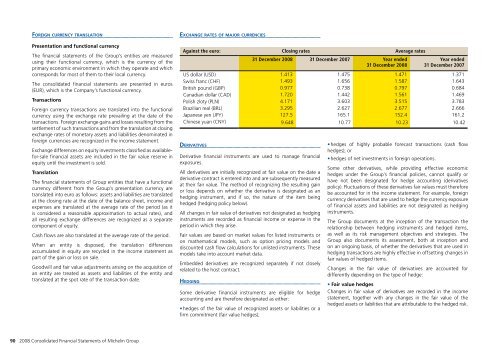MICHELIN - 2008 ANNUAL REPORT
MICHELIN - 2008 ANNUAL REPORT
MICHELIN - 2008 ANNUAL REPORT
You also want an ePaper? Increase the reach of your titles
YUMPU automatically turns print PDFs into web optimized ePapers that Google loves.
FOREIGN CURRENCY TRANSLATION<br />
Presentation and functional currency<br />
The financial statements of the Group’s entities are measured<br />
using their functional currency, which is the currency of the<br />
primary economic environment in which they operate and which<br />
corresponds for most of them to their local currency.<br />
The consolidated financial statements are presented in euros<br />
(EUR), which is the Company’s functional currency.<br />
Transactions<br />
Foreign currency transactions are translated into the functional<br />
currency using the exchange rate prevailing at the date of the<br />
transactions. Foreign exchange gains and losses resulting from the<br />
settlement of such transactions and from the translation at closing<br />
exchange rates of monetary assets and liabilities denominated in<br />
foreign currencies are recognized in the income statement.<br />
Exchange differences on equity investments classified as availablefor-sale<br />
financial assets are included in the fair value reserve in<br />
equity until the investment is sold.<br />
Translation<br />
The financial statements of Group entities that have a functional<br />
currency different from the Group’s presentation currency are<br />
translated into euro as follows: assets and liabilities are translated<br />
at the closing rate at the date of the balance sheet, income and<br />
expenses are translated at the average rate of the period (as it<br />
is considered a reasonable approximation to actual rates), and<br />
all resulting exchange differences are recognized as a separate<br />
component of equity.<br />
Cash flows are also translated at the average rate of the period.<br />
When an entity is disposed, the translation differences<br />
accumulated in equity are recycled in the income statement as<br />
part of the gain or loss on sale.<br />
Goodwill and fair value adjustments arising on the acquisition of<br />
an entity are treated as assets and liabilities of the entity and<br />
translated at the spot rate of the transaction date.<br />
EXCHANGE RATES OF MAJOR CURRENCIES<br />
Against the euro: Closing rates Average rates<br />
31 December <strong>2008</strong> 31 December 2007 Year ended<br />
31 December <strong>2008</strong><br />
Year ended<br />
31 December 2007<br />
US dollar (USD) 1.413 1.475 1.471 1.371<br />
Swiss franc (CHF) 1.493 1.656 1.587 1.643<br />
British pound (GBP) 0.977 0.738 0.797 0.684<br />
Canadian dollar (CAD) 1.720 1.442 1.561 1.469<br />
Polish zloty (PLN) 4.171 3.603 3.515 3.783<br />
Brazilian real (BRL) 3.295 2.627 2.677 2.666<br />
Japanese yen (JPY) 127.5 165.1 152.4 161.2<br />
Chinese yuan (CNY) 9.648 10.77 10.23 10.42<br />
DERIVATIVES<br />
Derivative financial instruments are used to manage financial<br />
exposures.<br />
All derivatives are initially recognized at fair value on the date a<br />
derivative contract is entered into and are subsequently measured<br />
at their fair value. The method of recognizing the resulting gain<br />
or loss depends on whether the derivative is designated as an<br />
hedging instrument, and if so, the nature of the item being<br />
hedged (hedging policy below).<br />
All changes in fair value of derivatives not designated as hedging<br />
instruments are recorded as financial income or expense in the<br />
period in which they arise.<br />
Fair values are based on market values for listed instruments or<br />
on mathematical models, such as option pricing models and<br />
discounted cash flow calculations for unlisted instruments. These<br />
models take into account market data.<br />
Embedded derivatives are recognized separately if not closely<br />
related to the host contract.<br />
HEDGING<br />
Some derivative financial instruments are eligible for hedge<br />
accounting and are therefore designated as either:<br />
hedges of the fair value of recognized assets or liabilities or a<br />
firm commitment (fair value hedges);<br />
hedges of highly probable forecast transactions (cash flow<br />
hedges); or<br />
hedges of net investments in foreign operations.<br />
Some other derivatives, while providing effective economic<br />
hedges under the Group’s financial policies, cannot qualify or<br />
have not been designated for hedge accounting (derivatives<br />
policy). Fluctuations of these derivatives fair values must therefore<br />
be accounted for in the income statement. For example, foreign<br />
currency derivatives that are used to hedge the currency exposure<br />
of financial assets and liabilities are not designated as hedging<br />
instruments.<br />
The Group documents at the inception of the transaction the<br />
relationship between hedging instruments and hedged items,<br />
as well as its risk management objectives and strategies. The<br />
Group also documents its assessment, both at inception and<br />
on an ongoing basis, of whether the derivatives that are used in<br />
hedging transactions are highly effective in offsetting changes in<br />
fair values of hedged items.<br />
Changes in the fair value of derivatives are accounted for<br />
differently depending on the type of hedge:<br />
Fair value hedges<br />
Changes in fair value of derivatives are recorded in the income<br />
statement, together with any changes in the fair value of the<br />
hedged assets or liabilities that are attributable to the hedged risk.<br />
90 <strong>2008</strong> Consolidated Financial Statements of Michelin Group

















